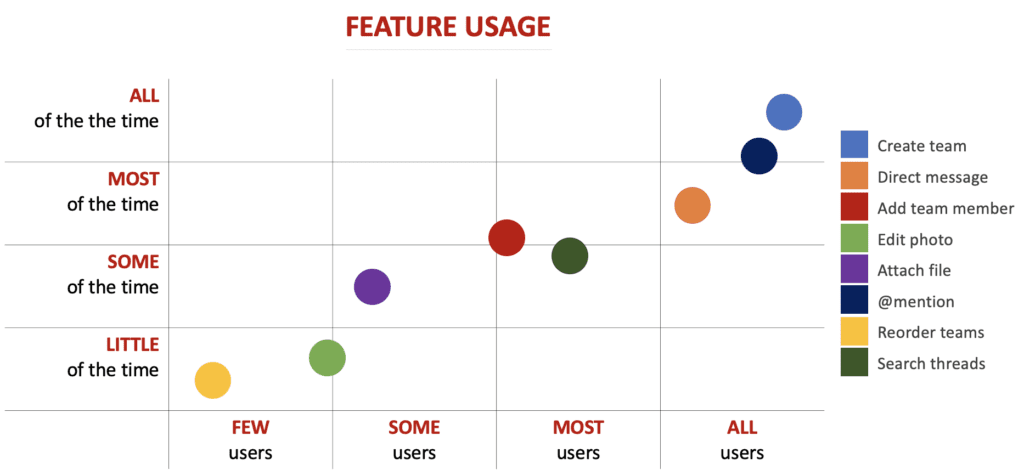What Is a Feature Audit?
In a feature audit, a product team reviews the usage levels of its product features and plots them on a graph. The graph charts two data points:
- the percentage of customers who use each feature (the x-axis)
- how often users access those features (the y-axis)
For companies that offer software or other digital products, performing a feature audit is simple. The product team can compile usage data online, using its backend database or web tools such as Google Analytics.
But for businesses that produce physical products, feature audits are more difficult to conduct. These product teams will need to rely on offline methods, such as surveys and customer interviews.

What’s the Advantage of Using a Feature Audit Graph?
As you can see from the sample feature audit graph above, this exercise gives a product team a simple way to visualize the usage of all product features. This process also lets the team present their findings to other stakeholders in a clear, elegant way.
If the product team wants to make the case that the time has come to retire a given feature, presenting a spreadsheet with numbers and percentages might not be persuasive. But if the team can show stakeholders a simple graph that depicts only a few people using the feature, and rarely—that can help the team make a more compelling case.
When Should a Product Team Conduct a Feature Audit?
Here are a few common scenarios when it makes business sense to perform a feature audit.
1. To learn which features resonate with customers, and which don’t.
You do not perform a feature audit hoping to find all your features in the upper-right corner of the graph—every customer using them all, all the time. That doesn’t happen with any product.
But a feature audit can let you know which features your users find most valuable. That is important because it lets your team know whether or not you are focusing your attention on things your customers care about.
Product teams often find the results of their feature audits surprising. A team might assume customers would gravitate to the two or three features the team prioritized on the roadmap, but instead find another feature becoming the star of the product. That’s why feature audits are important strategic exercises.
2. To check on the effectiveness of your product layout and UI.
A feature audit can also serve as a sanity check on the intuitiveness of your product’s interface. A team’s product managers, UX designers, and developers might agree the product is easy to navigate.
But when they review the usage details, they might discover customers are ignoring the product’s flagship features—the features that focus-group members said would compel them to buy the product.
If a feature audit reveals that your users are not using the features they said would be very important to them, that might be a signal that your product’s UI makes it difficult to find those features.
3. To find out whether or not your product is making an IMPACT.
Finally, a feature audit can provide an objective assessment of customer engagement with your product. If the overall engagement levels are low for features across the board, this can signal that your product is not having the IMPACT your team anticipated.
Annie Dunham, ProductPlan’s Vice President of Product, makes this case in her book about a new type of product management mindset, called IMPACT.
With Annie’s IMPACT concept, a product team asks itself these six questions:
- I – Interesting: Does the product address the things our customers care about? Can we tell a story of how the product creates positive change for them?
- M – Meaningful: Are we moving the business forward toward measurably reaching its goals? Are we providing real value to our users?
- P – People: Who is impacted by our product? Who uses it, who sees the benefits, and who pays for it?
- A – Actionable: Are we coming up with ideas that can be implemented and realized? Do we have the resources, budget, and expertise to execute?
- C – Clear: Do we truly understand what we’re trying to do? Can it be concisely articulated so even a child could understand?
- T – Testable: Can you try things out before making a major commitment? Are there ways to experiment and measure success on an ongoing basis?
A feature audit can help a product team answer several of these questions. For example, is the product interesting? Viewing a graph of feature engagement can alert the team if overall usage is low.
Also, are the features testable? A product team can release a minimum viable feature, plot its usage on a feature audit graph, and learn whether customers have an interest—before committing more resources to development.
Related Terms
minimum viable feature (MVF), key performance indicator (KPI), feature factory, prioritization, agile framework
